
ISSN: 2615-9740
JOURNAL OF TECHNICAL EDUCATION SCIENCE
Ho Chi Minh City University of Technology and Education
Website: https://jte.edu.vn
Email: jte@hcmute.edu.vn
JTE, Volume 19, Special Issue 03, 2024
80
Develop an RS-485 Protocol for Arduino Boards Applied To Networked Real
Time Control Systems
Dang Long Tran1* , Truong Hoa Binh Nguyen1, Nam Hoa Ho1, Duy Anh Nguyen1, Van Danh
Tran2, Minh Nhat Nguyen2, Duc Chanh Tin Doan2
1Ho Chi Minh City University of Technology, Vietnam National University Ho Chi Minh City, Vietnam
2Institute for Nanotechnology, Vietnam National University Ho Chi Minh City, Vietnam
*Corresponding author. Email: trandanglong@hcmut.edu.vn
ARTICLE INFO
ABSTRACT
Received:
12/08/2023
The Arduino microprocessor boards such as Mega 2560, UNO R3,
Leonardo, Micro, and Nano are simple and low-cost tools for real-time
measurement and control applications. These Arduino boards cannot be
used in distributed systems because they lack the networking capabilities
to transfer data across units. In this study, an RS-485 protocol for Arduino
boards that operate in Master-Slave networks was developed. Network
operations could be carried out independently on the main thread program,
and devices in the network could react quickly to information received.
This was made possible by the asynchronous serial communication feature
and a high-speed timer provided in Arduino boards. The networks designed
in this study were applied to an electric vehicle model with all-wheel drive
and all-wheel steering capabilities for supermaneuverability as well as a
saltwater intrusion early warning system installed in a river entry. The
results showed that highly reliable and stable network operations could be
achieved, thus extending the usage of popular Arduino boards for
networked real-time applications.
Revised:
25/09/2023
Accepted:
29/11/2023
Published:
28/08/2024
KEYWORDS
Arduino board;
RS-485 protocol;
Master-Slave network;
Supermaneuverable EV;
Saltwater intrusion.
Doi: https://doi.org/10.54644/jte.2024.1445
Copyright © JTE. This is an open access article distributed under the terms and conditions of the Creative Commons Attribution-NonCommercial 4.0
International License which permits unrestricted use, distribution, and reproduction in any medium for non-commercial purpose, provided the original work is
properly cited.
1. Introduction
Arduino microprocessor boards are a low-cost, high performance development platform widely used
in embedded system applications [1]-[7]. The platform supports basic communication protocols such as
UART, I2C, and SPI. While the I2C allows multiple devices to connect and form a local network with a
maximum transmission distance of less than one meter, the UART and SPI only allow communication
between two devices. Consequently, Arduino boards are not suitable for distributed data acquisition and
control systems in which sensors and actuators exchange data with controllers over long distances via
network protocols.
In comparison to UART, I2C, and SPI, the RS-485 protocol supports high speed serial data
transmission over much longer distances, up to thousands of meters, at speeds of up to 1 mega bits per
second. The RS-485 also supports Master-Slave communication model where one device, referred to as
the Master, controls and directs the actions of up to 31 subordinate devices, known as Slaves, allowing
for increased flexibility and scalability. The RS-485 also has high reliability and noise immunity by
means of using a twisted pair cable, ensuring stable data transmission even in noisy environments. These
advantages make the RS-485 particularly useful in IoT and industrial applications where connecting to
remote devices is necessary [8].
It is clear that with RS-485 networking functionality, an Arduino-based device can connect and
communicate with multiple devices on a single network, expanding the application capabilities and
enhancing the Arduino platform's versatility. To make Arduino boards running with the RS-485 protocol
by firmware is less expensive than using higher performance microprocessor boards having an
integrated CAN protocol which is handled by hardware. Furthermore, whereas the CAN protocol
specifies a fixed data frame length, the RS-485 protocol is completely customizable.

ISSN: 2615-9740
JOURNAL OF TECHNICAL EDUCATION SCIENCE
Ho Chi Minh City University of Technology and Education
Website: https://jte.edu.vn
Email: jte@hcmute.edu.vn
JTE, Volume 19, Special Issue 03, 2024
81
This study is aimed to develop an RS-485 protocol for commonly used Arduino boards such as Mega
2560, UNO R3, Micro, and Nano for real-time control over the Master-Slave network architecture. By
using an external UART/RS-485 interfacing hardware in conjunction with the UART communication
and a high speed timer provided in Arduino boards, network operations of each Arduino board including
serial data transmission, message frame generation and interpretation, network communication control
can be carried out independently of the main thread program, and devices in the network can react
quickly to information received.
The paper is organized as follows. Section 2 describes the overall design of an RS-485 Master-Slave
network using Arduino boards including network configuration, message frame format, and data flows.
Section 3 introduces algorithms for message transmission and receive with fast response. Section 4
demonstrates the use of the newly developed RS-485 network in automotive and environmental
domains. Finally, in the Conclusion, key findings are summarized.
2. Overall design of RS-485 Master-Slave network using Arduino boards
To built an RS-485 protocol for Arduino boards, network configuration, message frame format, and
data flows have to be first determined.
2.1. Network configuration
Figure 1. The schematic diagram of an RS-485 network using Arduino microprocessor boards having (n+1)
devices, including one Master and n Slaves.
An RS-485 Master-Slave network consists of a Master device and several Slave devices. All devices
are physically connected via a single communication called a bus which is a pair of wires (one called
the “A” and the other called “B”) with 120 resistors at each end to minimize signal reflections,
preventing signal degradation. Data bits are broadcasted by one of the devices to all the others in terms
of balanced differential signals in the “A” and “B” wires. The Master controls the communication by
sending data packets (also called message) to the Slaves, and the Slaves respond as needed. Generally,
the Master controls, acquires information and send commands to the Slave devices, and the Slaves carry
out tasks assigned by the Master. For addressing, the Master and the Slaves have different ID numbers.
To build this type of network for Arduino boards, the UART function provided by the Arduino board
is used for serial data transmission and receive via the TX and RX pins (Figure 1). Each Arduino board
needs an external RS-485 transceiver as its UART/RS-485 interface to access the network. Data flow
direction between the Arduino board and the network is selected by a Read/Write control signal. With
a read command (e.g. Read/Write = “1”), the Arduino board listens to the network and receives all data
bits broadcasted. With a write command (e.g. Read/Write =”0”), the Arduino board is the source of data
broadcasting. To avoid data collision, only one source of data broadcasting is allowed at a time.
2.2. Message frame format
As presented in Figure 2, each message sent over the network consists of three parts: a Header, a
Payload, and a Trailer. In this study, the Header field has four bytes, including a pre-defined character
as Start-of-Frame (SOF), the source ID number, the destination ID number, and the number of Payload
bytes (so-called the Data Length (DL)). The Payload field contains application data that are needed to

ISSN: 2615-9740
JOURNAL OF TECHNICAL EDUCATION SCIENCE
Ho Chi Minh City University of Technology and Education
Website: https://jte.edu.vn
Email: jte@hcmute.edu.vn
JTE, Volume 19, Special Issue 03, 2024
82
be sent to the destination. The Trailer field is designed with four bytes, including three reserved bytes
and a pre-defined character as End-of-Frame (EOF). The total frame length is N+8 bytes.
Figure 2. The message frame format of the RS-485 Master-Slave network proposed in this study. Numbers
indicate the number of bytes in each field. The total frame length is N+8 bytes. SOF-Start of Frame. EOF-End of
Frame.
Because a message is transmitted as a bit stream, the user-defined SOF and EOF characters are used
to recognize a complete message frame from which the contents of all fields can be extracted.
The Master initiates a communication by sending a message to one of the Slaves. In this message,
the source ID number is the Master ID number, and the destination ID number is the ID number of the
Slave that needs to subsequentially response. Therefore, all the Slaves simultaneously receive the
message sent by the Master but only one Slave that is specified by the destination ID responses while
all the others ignore the message.
2.3. Data flows
Figure 3. Data flows in an Arduino board connected to the RS-485 network. Message generation and
interpretation can be varied correspondingly to specific applications. Message transmission and receive are
developed in this study to achieve fast operation.
In each Arduino board, application data that needs to be sent through the network is stored in a TX
buffer, and application data received from the network is stored in an RX buffer. These two buffers are
manipulated in the main process of the Arduino program. To broadcast application data to the network,
the TX buffer content is considered as a payload and is transferred from the main process to a network
communication process, where a header and a trailer with appropriate contents are attached to form a
complete message frame. The produced message frame is then transferred to a message transmitting and

ISSN: 2615-9740
JOURNAL OF TECHNICAL EDUCATION SCIENCE
Ho Chi Minh City University of Technology and Education
Website: https://jte.edu.vn
Email: jte@hcmute.edu.vn
JTE, Volume 19, Special Issue 03, 2024
83
receiving process running in a timer interrupt service routine, where this message waits to be transferred
to a serial write buffer at a desired time. Each byte of the serial write buffer is sequentially copied to the
empty UART TX shift register of the Arduino microprocessor by the internal Arduino process. Once
the TX shift register gets a new byte, its bits are automatically emitted out of the TX pin of the Arduino
board as a bit stream until it is empty again.
Depending on the Read/Write control signal, each Arduino board can be in either the default
Listening mode or the Sending mode. Prior to the bit stream transmission, the Read/Write control signal
is set to the Write value (e.g. “0”) to dominate the communication line for broadcasting. Once
transmission is completed, the Read/Write control signal should be set to the Read value (e.g. “1”) as
soon as possible, quickly releasing the communication line.
In the listening mode, the bit stream sent over the network is automatically captured as bytes and
stored in the UART RX shift register by the Arduino microprocessor, subsequentially transferred to a
serial read buffer by the internal Arduino process. The message transmitting and receiving process have
to regularly check the serial read buffer for new received bytes and searchs for a complete message
frame basing on the pre-defined SOF and EOF characters. Once detected, the Header, the Payload, and
the Trailer are segmented from the frame. The destination ID number is checked to defined whether the
received Payload is safely neglected or not. If the ID number of the destination is identical to that of the
receiver, message parts are transferred to the network communication process, and then only the Payload
is transferred to the main process for further manipulations.
The data flows mentioned above is illustrated in Figure 3. The network communication process can
be varied depending on specific applications. Data transfers between the message transmitting and
receiving process and the internal Arduino process are carried out using the common Arduino Serial
library. Meanwhile, a message transmitting and receiving process need to be developed in this study so
that a fast response of the destination device can be achieved, allowing high rates of data packet sent
through the network.
3. Algorithm for message transmission and receive with fast response
Figure 4. Data transfer between the Master and a Slave using the proposed algorithm for message transmission
and receive. Numbers indicate network events:
-Start of a transmission;
-End of a transmission;
-
Communication line release; and
-Message detection.
Several algorithms for message transmission and receive have been built so far for Arduino boards
[9]-[11]. However, these algorithms mostly run in the main thread program. The incoming message thus
cannot be detected quickly, increasing the dead time before response. Consequently, the rate of message
sent over the network is limited, suppressing the use of these algorithms for real-time control systems.
In this study, the message transmitting and receiving process is separated from the main process and is

ISSN: 2615-9740
JOURNAL OF TECHNICAL EDUCATION SCIENCE
Ho Chi Minh City University of Technology and Education
Website: https://jte.edu.vn
Email: jte@hcmute.edu.vn
JTE, Volume 19, Special Issue 03, 2024
84
carried out regularly to catch the time right after a transmission is completed. In the case of the sender,
the Read/Write control signal is then switched from Write to Read almost immediately to release the
communication line for other devices. In the case of the receiver, the response message waiting to be
sent can be transmitted out as soon as possible. Therefore, the dead time between two consecutive
message transmissions is minimized, and the communication cycle can be small enough for high rates
of message requested by real-time control systems.
In this algorithm, a high speed timer available in Arduino board is used as a synchronizing trigger
source to regularly jump from the current program process to its interrupt service routine where the
message transmitting and receiving process runs. In this process, if the Arduino board is in the Listening
mode, the serial read buffer is checked for new received bytes, and the pre-defined SOF and EOF
characters are searched to detect a complete message. In the Sending mode, the communication line is
released if the UART transmission is finished. Generally, there are four network events sequentially
occuring as illustrated in Figure 4:
1. Start of a transmission: the Read/Write control signal is set to the Write value and the outgoing
message is copied to the empty serial write buffer in the message transmitting and receiving process,
followed by an UART transmission carried out in the internal Arduino process;
2. End of transmission: the UART transmission is finished;
3. Communication line release: the Read/Write control signal is set to the Read value in the message
transmitting and receiving process;
4. Message detected: the message transmitting and receiving process successfully detected a
complete message in the serial read buffer, then the destination ID number is checked whether the
payload content is safely neglected or not.
Depending on the baudrate of the network selected in a range from several kbps to 1 Mbps, the
synchronizing trigger interval can be set correspondingly from 1 ms to 0.01 ms for the fastest response.
4. Results and Discussion
4.1. Automotive application: A supermaneuverable electric vehicle model
The RS-485 Master-Slave network designed above was applied to a miniature model of 4x4 electric
vehicle with all-wheel drive and all-wheel steering capabilities as shown in Figure 5. In this vehicle
model, an encoder-integrated DC motor is installed at each wheel for independent wheel speed control.
Besides, a servomotor-driven steering mechanism is assembled at each wheel for independent wheel
steering angle control. As a result of this design, supermaneuverability can be achieved with four
steering modes, including front-wheel steering as normal vehicle, all-wheel steering for reduced steering
radius at low speeds, diagonal driving for changing lane with zero yaw motion, and zero turn. It is
important to be noted that the rotational speed and steering angle of a wheel must be synchronized to
those of others to satisfy the steering kinematics required by each steering mode.
Using only one expensive, high performance multi-core microprocessor board that can
simultaneously handle all quadrature encoder readings, closed-loop wheel speed controls and wheel
steering angle controls is a programming burden to achieve real-time operation. Electrical wiring is also
a burden with a lots of wire bunches connecting the microprocessor board to all motor drives, motors,
and encoders. By applying a RS-485 Master-Slave network using low-cost Arduino Micro Pro boards,
efforts for real-time programming was significantly reduced since all devices could be programmed
independently. Electrical wiring was also much simpler because only one pair of wire was used to
connect all devices. For each steering mode, the vehicle motion controller (referred to as the Master)
calculates wheel’s speeds and steering angles needed to ensure that all wheels roll around the same
turning center. Then, all calculated speed and steering angle considered as desired setpoint values for
closed-loop controls are transmitted via the RS-485 bus wire to all wheel motion controllers (referred to
as the Slaves). In each Slave, the speed and steering angle setpoints assigned to its wheel are extracted
from the received message frame for further processings. Once the Master’s transmission is completed,
the Slave 4 immediately response its current actual wheel speed and PWM outputs for motor controls,
followed by the response of the Slave 3, then the Slave 2, and finally the Slave 1. Once the Slave 1’s
transmission is finished, the network comes to a break time and waits for the next Master’s transmission.

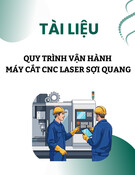

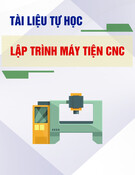
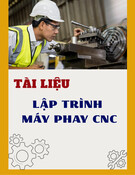
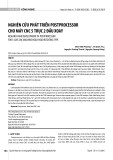
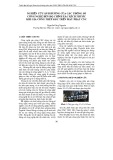

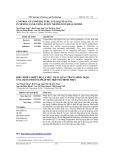
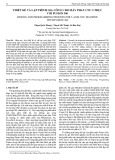
![Giáo trình Máy phay CNC nâng cao (Nghề Cắt gọt kim loại) - CĐ Cơ Giới Ninh Bình [PDF]](https://cdn.tailieu.vn/images/document/thumbnail/2021/20210520/calliope09/135x160/3041621505507.jpg)
![Đề cương ôn thi Nguyên lý máy [mới nhất]](https://cdn.tailieu.vn/images/document/thumbnail/2026/20260106/cuchoami2510/135x160/90481767694770.jpg)














